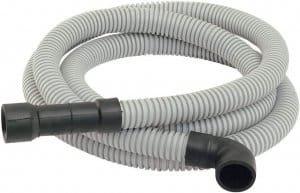A dishwasher is one of the most important appliances in any modern kitchen. It helps save time and energy by automating the dishwashing process, leaving you free to focus on other tasks.
However, if your GE dishwasher is not draining, it can be frustrating and even prevent you from using the appliance altogether.
In this article, we will explore some of the common reasons why your GE dishwasher may not be draining and what you can do to fix the issue.
Before we dive into the possible causes and solutions, it is important to understand the mechanics of how a dishwasher works.
Dishwashers have a drain pump that is responsible for pumping out the dirty water from the appliance after each wash cycle.
The water is drained through a hose that is connected to your home’s plumbing system. If the drain pump or hose is clogged or damaged, the dishwasher will not be able to drain properly.
Now let’s look at some of the reasons why your GE dishwasher may not be draining:
Table of Contents
Clogged Drain Hose:
A clogged drain hose is one of the most common reasons why a dishwasher may not be draining. Over time, food particles, grease, and other debris can accumulate in the drain hose, causing it to become blocked.

To check if the drain hose is clogged, you can remove it from the dishwasher and check for any blockages. If there is a blockage, you can use a plumbing snake or a long, flexible brush to remove it.
Clogged Drain Pump:
The drain pump is responsible for pumping out the dirty water from the dishwasher. If the drain pump is clogged, it will not be able to pump out the water, and the dishwasher will not drain properly.
To check if the drain pump is clogged, you can remove the pump and inspect it for any blockages. If there is a blockage, you can use a small brush or toothbrush to remove it.
Faulty Drain Pump:
If the drain pump is not clogged but still not working, it may be faulty and need to be replaced. A faulty drain pump can prevent the dishwasher from draining properly, and you may notice a humming sound when the dishwasher is trying to drain.
To replace the drain pump, you will need to order a new one and follow the manufacturer’s instructions for installation.
Clogged Garbage Disposal:
If your dishwasher is connected to a garbage disposal, it is important to check if the disposal is clogged. If the garbage disposal is clogged, it can prevent the dishwasher from draining properly.
To check if the disposal is clogged, you can turn off the power and remove the drain plug. You can then use a flashlight to check for any blockages. If there is a blockage, you can use a plunger or a plumbing snake to remove it.
Faulty Check Valve:
The check valve is a small device that prevents water from flowing back into the dishwasher after it has been drained. If the check valve is faulty, it can prevent the dishwasher from draining properly.
To check if the check valve is faulty, you can remove it and inspect it for any damage. If the valve is damaged, you will need to replace it.
Now that we have explored some of the common reasons why your GE dishwasher may not be draining, let’s look at what you can do to fix the issue:
Clean the Drain Hose:
If the drain hose is clogged, you can remove it from the dishwasher and clean it using a plumbing snake or a long, flexible brush.
Once you have removed the blockage, you can reconnect the hose and test the dishwasher to see if it is draining properly.
Clean the Drain Pump:
If the drain pump is clogged, you can remove it from the dishwasher and clean it using a small brush or toothbrush.
Once you have removed the blockage, you can reinstall the drain pump and test the dishwasher to see if it is draining properly.
Replace the Drain Pump:
If the drain pump is faulty, you will need to order a new one and follow the manufacturer’s instructions for installation. You can order a replacement drain pump online or from your local appliance repair store.
Check the Garbage Disposal:
If your dishwasher is connected to a garbage disposal, you can check if the disposal is clogged by turning off the power and removing the drain plug.
You can then use a flashlight to check for any blockages. If there is a blockage, you can use a plunger or a plumbing snake to remove it.

Replace the Check Valve:
If the check valve is faulty, you will need to order a new one and follow the manufacturer’s instructions for installation. You can order a replacement check valve online or from your local appliance repair store.
In addition to the above steps, there are some general maintenance tips that you can follow to ensure that your GE dishwasher continues to drain properly:
Scrape off any food debris before loading the dishwasher: This can help prevent food particles from clogging the drain hose or pump.
Run the garbage disposal before running the dishwasher: This can help prevent the disposal from becoming clogged and interfering with the dishwasher’s draining process.
Regularly clean the dishwasher: You can use a dishwasher cleaner or a mixture of vinegar and baking soda to clean the dishwasher and prevent any buildup of debris.
Check the dishwasher’s filter: Some GE dishwashers have a filter that needs to be cleaned regularly. You can refer to your dishwasher’s manual for instructions on how to clean the filter.
What causes a GE dishwasher to not drain?
A GE dishwasher not draining could be caused by a few different issues.
One potential cause is a clogged drain hose. The drain hose carries water from the dishwasher to the sink or garbage disposal and can become clogged with food particles, grease, or other debris.
To check for a clog, remove the drain hose from both ends and inspect it for any blockages. If you find a clog, use a wire hanger or other tool to carefully remove it before reattaching the hose.
Another possible cause is an issue with the drain pump. If the pump has burned out or is otherwise malfunctioning, it won’t be able to move water out of the dishwasher.
This can be diagnosed by checking for power at the pump motor terminals with a multimeter and testing the motor itself with an ohmmeter. If either of these tests indicate an issue with the pump, it should be replaced.
Why is there standing water in my GE dishwasher?
Standing water in your GE dishwasher could be caused by a few different factors. First, it could be due to a clogged drain hose or filter. Over time, food particles and other debris can accumulate in the drain hose or filter, blocking the flow of water out of the dishwasher. To fix this issue, you should check the drain hose and filter for any blockages and clean them out if necessary.
Another potential cause of standing water is a damaged or blocked pump impeller. The pump impeller is responsible for pushing water through the drain hose and out of the dishwasher.
If it is damaged or blocked, it won’t be able to do its job properly and will leave standing water inside the dishwasher. To fix this issue, you should inspect the pump impeller and replace it if necessary.
Finally, standing water could also be caused by an issue with the float switch assembly.
How do I force my GE dishwasher to drain?
To force your GE dishwasher to drain, you will need to reset the appliance. First, locate the control panel on the front of the dishwasher. Then press and hold the Start/Reset button for 3-5 seconds.
This should cause the dishwasher to start draining any excess water that is in the unit. If this does not work, then you may need to disconnect power from the dishwasher for a few minutes and then reconnect it.
This should reset the appliance and allow it to drain properly. If these steps do not resolve your issue, contact a qualified repair technician for further assistance.
How do you unclog a GE dishwasher drain?
Unclogging a GE dishwasher drain is relatively straightforward.
First, remove the kickplate from the bottom of the dishwasher. This will give you access to the drain pump and filter. Take out the lower rack and unscrew the filter cover. Using a flashlight, check for any debris or food particles stuck in the filter and remove them with tweezers or a small brush.
Next, take out the drain pump by unscrewing it from its mountings and examine it for any blockages or clogs. If you find any, use a pair of needle-nose pliers to pull them out.
Clean both parts with warm water and a soft cloth before reassembling them back into place. Finally, run a cycle on your dishwasher to ensure that it’s draining properly.
Conclusion
In conclusion, a GE dishwasher not draining can be a frustrating problem, but with the right knowledge and tools, you can easily fix the issue.
By following the steps outlined in this article, you can identify the cause of the problem and take the necessary steps to ensure that your dishwasher continues to drain properly.
Remember to also follow the general maintenance tips to prevent future issues and keep your dishwasher running smoothly.




1 thought on “GE Dishwasher Not Draining”
Comments are closed.